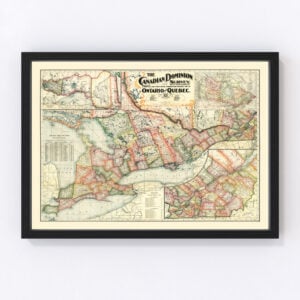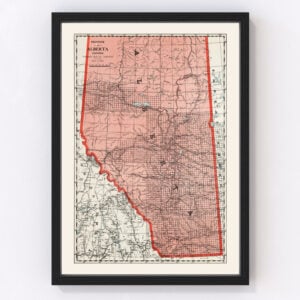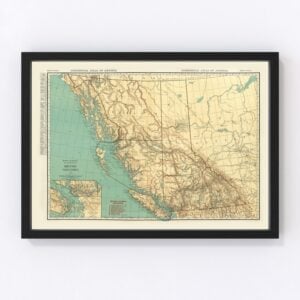Old Maps of Canada
Browse through our collection of Old Maps of Canada.
Canada is a country located within North America, covering over 9.98 million square kilometers (or 3.85 million square miles). Its border shared with the United States stretches out around 8,891 kilometers (5,525 miles), making this the longest nation border in the world. With a population of around 37 million inhabitants, the three most populated cities are Toronto, Montreal, and Vancouver. The capital of Canada is Ottawa. Canada considers itself a “cultural mosaic” due to the amount of languages and different cultures within the country. The official languages of Canada are English and French, however Chinese, Punjabi, Spanish, Tagalog, and Arabic are fairly common to find as well.
Canada is a country surrounded by all forms of water. In fact, counting the area including the water found in Canada, it is the second largest country in the world following Russia. Did you know that Little Manitou Lake has a mineral salt concentration of 180,000 mg per liter, making this extremely buoyant water, similar to the Dead Sea in the Middle East. Because of its great size, there exists a wide variety of climates found within Canada. The ocean currents surrounding the country play a key role in the coolness of the country, as well as the precipitation. With the exception of the west coast of the country, all of Canada experiences winters with average below freezing temperatures and large amounts of snow.Forest regions are the most common in Canada. In fact, Canada is home to the northern coniferous forest, which is the second largest area of uninterrupted forest in the world, following Russia. This forest plays a key role in the wood and lumber industry for Canada. The largest wildlife region found in Canada is the Scotts Island Marine National Wildlife Area, which is home to over 40% of British Columbia's seabird population. Because of such a vast mix of landscape within Canada, half of the Canadian landscape is unpopulated.
Since Canada is a well developed country, the population is much older. The average age of a Canadian citizen is 41.4 years old as of 2018, and the average life expectancy is around 81.1 years. The 2021 Canadian census showed a population increase of around 5.2% compared to the 2016 census. The reasoning for this is immigration, as immigrants made up around two thirds of this growth. Canadian citizens are fairly healthy individuals, with 88% of all Canadians being reported has “having great health”. Healthcare in Canada is publicly funded for, meaning that it is free of charge for all citizens.
Canada is not only considered a “full democracy”, but also a constitutional monarchy, with Queen Elizabeth II of Britain reigning over each of Canada’s 10 provinces. Currently, Justin Trudeau is serving as the country’s 23rd prime minister. Canada is made up of three regions, and ten provinces. These provinces are each in charge of their own social programs like education, health care, and welfare. Along with this, each province is in charge of their own administration of justice, but not criminal law.
























Old Maps of Canada
Browse through our collection of Old Maps of Canada.
Canada is a country located within North America, covering over 9.98 million square kilometers (or 3.85 million square miles). Its border shared with the United States stretches out around 8,891 kilometers (5,525 miles), making this the longest nation border in the world. With a population of around 37 million inhabitants, the three most populated cities are Toronto, Montreal, and Vancouver. The capital of Canada is Ottawa. Canada considers itself a “cultural mosaic” due to the amount of languages and different cultures within the country. The official languages of Canada are English and French, however Chinese, Punjabi, Spanish, Tagalog, and Arabic are fairly common to find as well.
Canada is a country surrounded by all forms of water. In fact, counting the area including the water found in Canada, it is the second largest country in the world following Russia. Did you know that Little Manitou Lake has a mineral salt concentration of 180,000 mg per liter, making this extremely buoyant water, similar to the Dead Sea in the Middle East. Because of its great size, there exists a wide variety of climates found within Canada. The ocean currents surrounding the country play a key role in the coolness of the country, as well as the precipitation. With the exception of the west coast of the country, all of Canada experiences winters with average below freezing temperatures and large amounts of snow.Forest regions are the most common in Canada. In fact, Canada is home to the northern coniferous forest, which is the second largest area of uninterrupted forest in the world, following Russia. This forest plays a key role in the wood and lumber industry for Canada. The largest wildlife region found in Canada is the Scotts Island Marine National Wildlife Area, which is home to over 40% of British Columbia's seabird population. Because of such a vast mix of landscape within Canada, half of the Canadian landscape is unpopulated.
Since Canada is a well developed country, the population is much older. The average age of a Canadian citizen is 41.4 years old as of 2018, and the average life expectancy is around 81.1 years. The 2021 Canadian census showed a population increase of around 5.2% compared to the 2016 census. The reasoning for this is immigration, as immigrants made up around two thirds of this growth. Canadian citizens are fairly healthy individuals, with 88% of all Canadians being reported has “having great health”. Healthcare in Canada is publicly funded for, meaning that it is free of charge for all citizens.
Canada is not only considered a “full democracy”, but also a constitutional monarchy, with Queen Elizabeth II of Britain reigning over each of Canada’s 10 provinces. Currently, Justin Trudeau is serving as the country’s 23rd prime minister. Canada is made up of three regions, and ten provinces. These provinces are each in charge of their own social programs like education, health care, and welfare. Along with this, each province is in charge of their own administration of justice, but not criminal law.
